DocSend is a unique software that gives sales teams a wide array of features to manage documents, connect to a CRM, and facilitate engagement through communication tools.
At its core, DocSend is just a secure document-sharing platform. But since it can support the right content types for marketing and sales, track content performance, observe file interactions, automate workflows, and provide insights, it is also popular for those industries.
However, companies might need help to compromise due to its higher pricing than other competitors at a premium level. For the best alternative, see our complete list of top alternatives to DocSend below.
What is DocSend?
DocSend is a document management software that can also serve as a sales enablement tool due to its analytics, signature, document sharing, and tracking capabilities. Users can securely and efficiently share documents while capturing user behavior metrics like time spent, pages viewed, etc.)
Although it has basic sharing controls, these features can save time and do the job fairly well. It also allows users to integrate Salesforce for streamlined analytics. Customizable branding and other customizations like gating agreements and watermarking can be added.
While DocSend is a phenomenal tool for those who want to share and track sensitive documents securely, first-time users may find it difficult and expensive initially.
Pros:
- Provides advanced security and tracking features for shared files.
- Tracks file access, viewer details, and user engagement.
- User-friendly for easy folder and file sharing, facilitating content management.
- Simple and reliable for sharing links and obtaining signatures.
- Contract signing and share link functionality are predictable and easy.
Cons:
- Differentiating between content and spaces can be confusing.
- Custom link creation may be challenging.
- The personal version lacks reporting, with a significant price jump for more features.
- Data room design aesthetics have received negative feedback.
- Higher pricing, lacking a cost-effective plan for minimal use.
Plans & Pricing:
- Personal ($15)
- Standard ($65)
- Advanced ($250)
Customer Ratings:
- G2: 4.6 out of 5 (481 reviews)
- Capterra: 4.6 out of 5 (60 reviews)
10 DocSend Alternatives in 2024
While DocSend can help you distribute docs easily, the confusing UI and high price might be too impactful to ignore based on financial and productivity factors. Find the right alternative to DocSend from our list of top 10 alternatives and competitors below.
1. Ahsuite
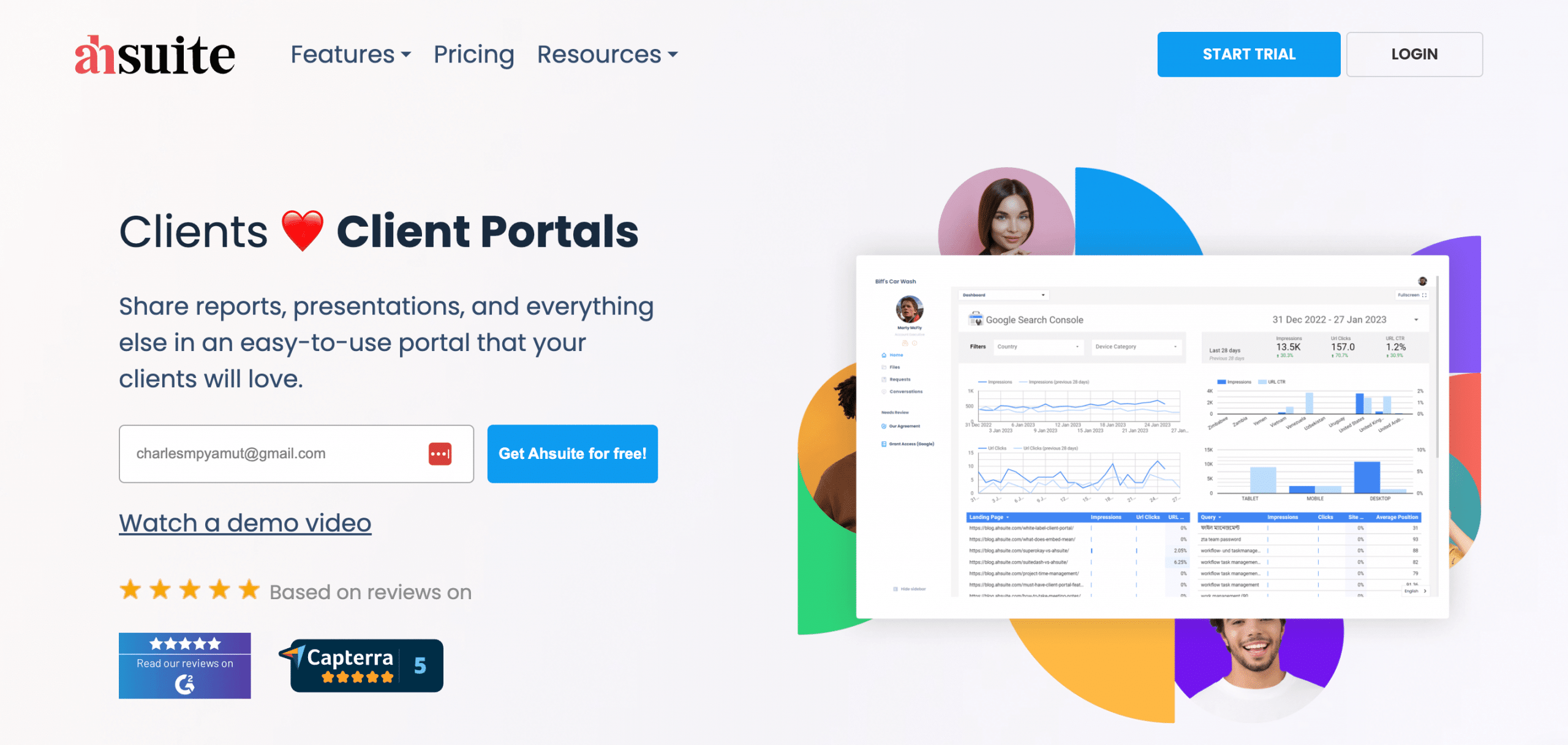
Ahsuite is a productivity and client management suite in one clean-looking SaaS platform. It provides an ecosystem for clients and teams to share documents and organize workflows with integrated task management, file management, and project management tools.
With its task, file, and password templates, you can reduce manual efforts while standardizing how you send files and collaborate with other team members. As a platform for sharing and receiving sensitive documents, it uses 245-bit encryption to protect client information.
Pros:
- Offers flexible template-making for files, tasks, and client portals.
- Assign and track tasks with clients within a clean user interface.
- Admins can set supported file types, enhancing security.
- Bundles important files together, enabling direct page creation.
- Editable file visibility options: team only, all team, or client only.
Cons:
- The documentation system could be improved.
- The client approval process needs enhancements.
- Lacks client invoicing management, though it’s being added to their roadmap.
- Needs a separate e-signature solution for signing documents.
Plans & Pricing:
- Starter (Free)
- Professional ($17)
- Agency ($29)
Customer Ratings:
- G2: 4.7 out of 5 (76 reviews)
- Capterra: 5 out of 5 (19 reviews)
2. Dropbox
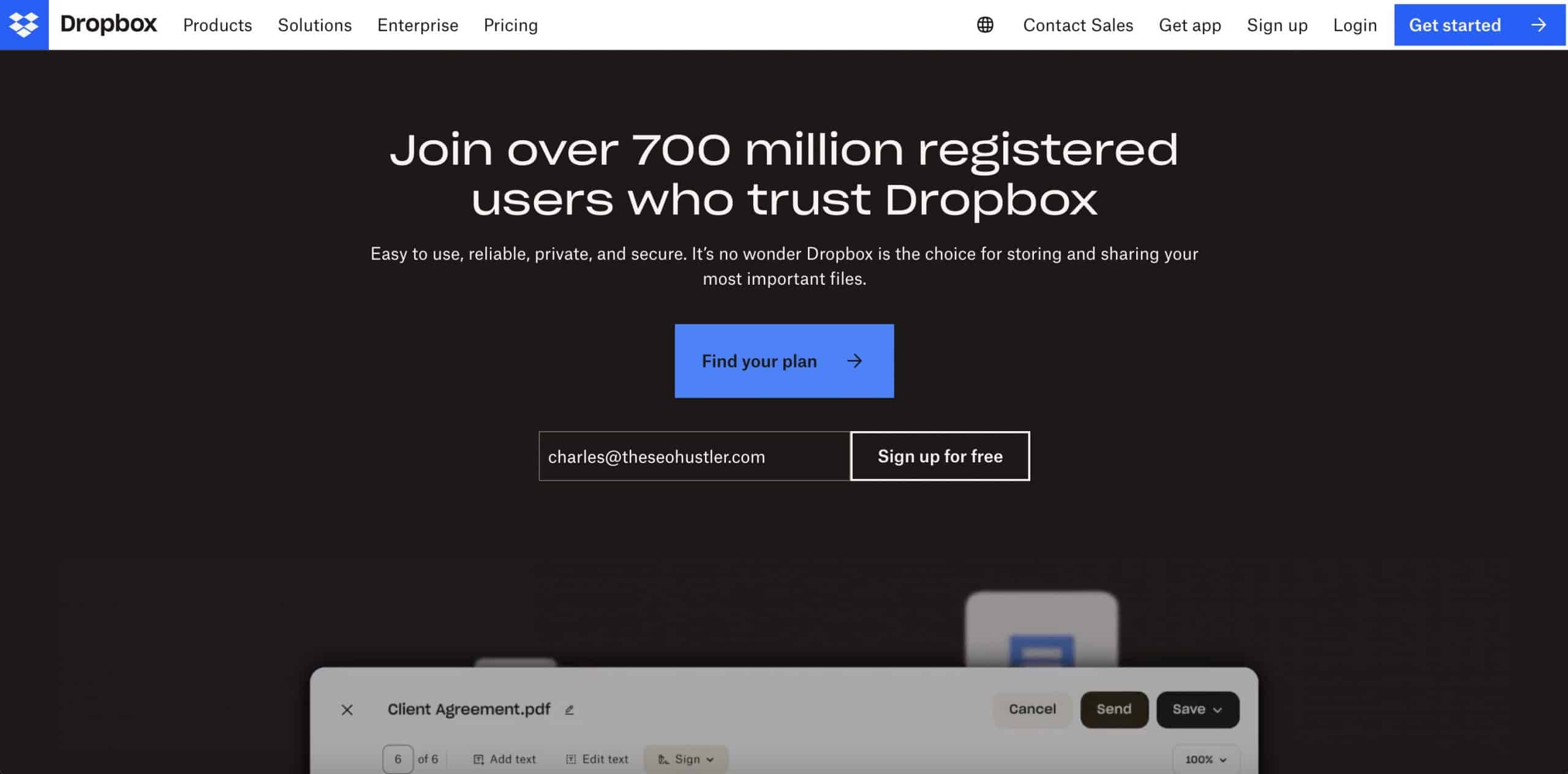
Dropbox is a cloud-based file storage and collaboration service that combines best-in-class security and syncing technologies for real-time document sharing. This file management software supports almost any device for accessibility and file reliability.
While its main focus is to securely share files, store backups, and provide large cloud capacity, Dropbox also provides basic document management tools to keep things organized and accessible. You can use Dropbox Sign for eSigning, but it might not be as robust as DocSend.
Pros:
- Integrates with most operating systems and devices.
- Enables document sharing across the company efficiently.
- Provides automatic file backup, ensuring work safety without fear of loss.
- Offers several subscription tiers to fit various needs.
- Files can be set as non-downloadable, password-protected, or with expiring links.
Cons:
- Cannot edit files online, complicating existing file modifications.
- Limited features for free users.
- Multiple users can’t work on the same file without creating separate versions.
- Advanced tracking and sales enablement features are missing.
- Limited storage flexibility without upgrading to a more expensive plan.
Plans & Pricing:
- Free (2GB)
- Plus ($11.99)
- Essentials ($22)
- Business ($24)
- Business Plus ($32)
- Enterprise (Contact Sales)
Customer Ratings:
- G2: 4.4 out of 5 (22,996 reviews)
- Capterra: 4.5 out of 5 (21,526 reviews)
3. PandaDoc
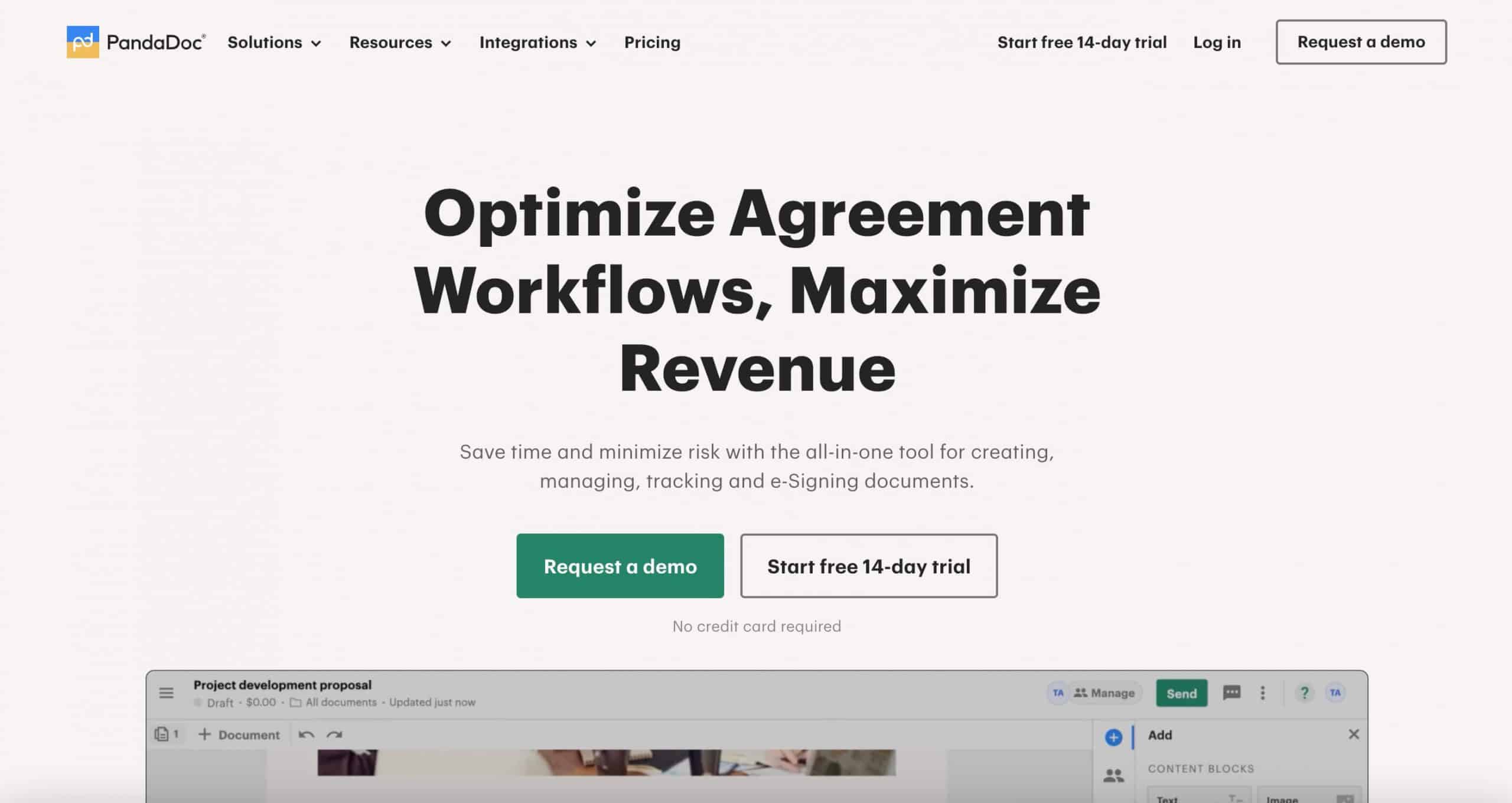
PandaDoc is an e-signature and document management platform used primarily for businesses that automate their workflows and are required to collect e-signatures as part of day-to-day operations. Similar to DocSend, it can also provide real-time tracking and Salesforce integration.
One of PandaDoc’s main focuses is simplifying document workflows and approval processes with templates, conditional logic, and features like advanced sales quotes, rich media drag and drag, document editor, and more.
Pros:
- Quickly generates first proposals, with a dashboard showing proposal stats.
- Useful default templates for starting documents.
- Document creation, formatting, and reminders are straightforward.
- Tables and page setups are easy to use and functional.
- The signature order setting allows copying without signing.
Cons:
- Timezone settings can display incorrect document creation dates.
- Emails sent to some customers end up as spam.
- Underutilized AI for document generation.
- Notifications are sent under the user’s name instead of the business.
Plans & Pricing:
- Essentials ($35)
- Business ($65)
- Enterprise (Contact Sales)
Customer Ratings:
- G2: 4.7 out of 5 (2,335 reviews)
- Capterra: 4.5 out of 5 (1,086 reviews)
4. DocuSign
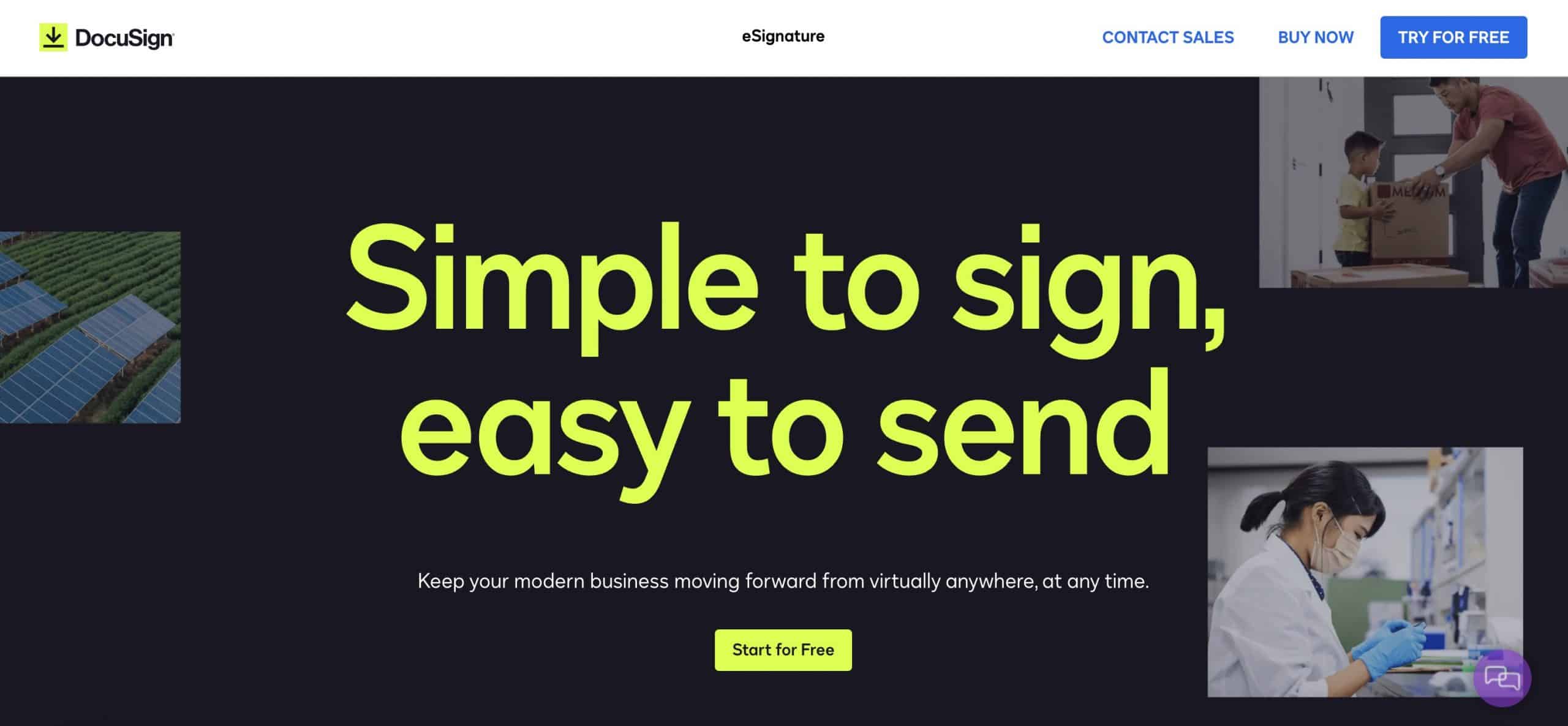
DocuSign is one of the best electronic signature software, with features like reusable templates, signer attachments, power forms, and multichannel delivery. Email notifications are sent to senders and recipients for updates and quick responses.
Since eSigns from DocuSign are legally binding, businesses worldwide trust and use this software to sign and manage documents. However, it doesn’t have in-depth content management and sales analytics features like DocuSend and other alternatives.
Pros:
- Great for contact execution and deal closure.
- Send multiple documents for signature quickly and easily.
- Excellent integration with other software, enhancing workflow efficiency.
- Reliable performance with no issues in page loading or navigation.
- Ensures legal and regulatory compliance through detailed audit trails.
Cons:
- Uploading documents via drag and drop can sometimes be problematic.
- Relatively expensive, especially for huge volume sign collection projects.
- Additional fees for advanced security and integrations increase costs.
- Limited options for customization, potentially hindering specific branding or workflow needs.
Plans & Pricing:
- Personal ($15)
- Standard ($45)
- Business Pro ($65)
- Enhanced Plans (Contact Sales)
Customer Ratings:
- G2: 4.5 out of 5 (2,318 reviews)
- Capterra: 4.8 out of 5 (8,516 reviews)
5. GetAccept
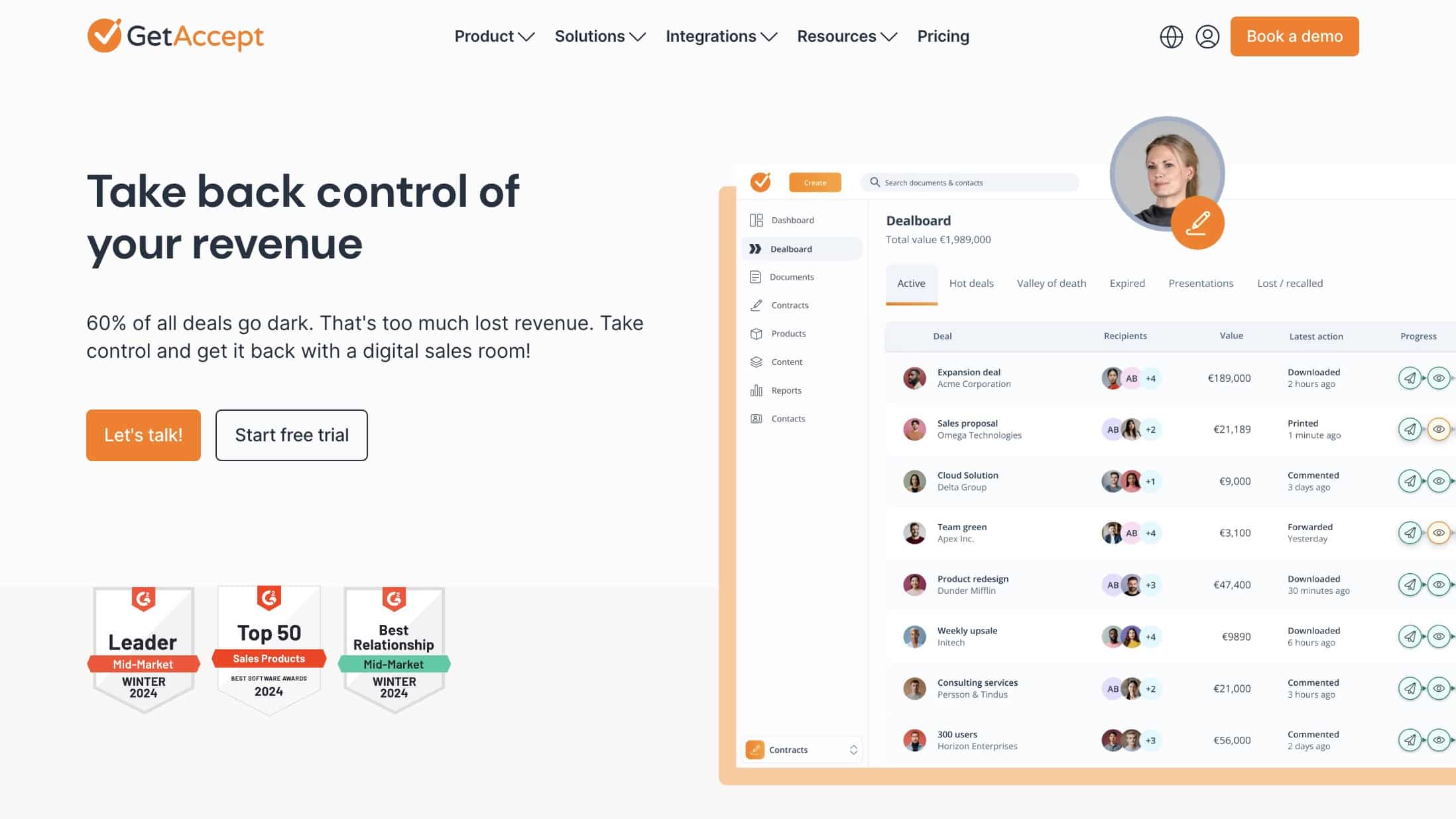
GetAccept provides a Digital Sales Room platform to keep the sales process active while maintaining accurate document tracking. Like other competitors to DocSend, GetAccept lets clients sign documents and automatically send supporting documents.
The platform’s focus on sales process productivity can be seen in its core solutions – eSignatures, proposals, analytics, and contact management. However, it might be overkill if your focus is more on document management than the actual sales process.
Pros:
- User-friendly interface with comprehensive e-signing features.
- Simplifies tracking deals and monitoring client engagement.
- Allows personalized interactions with clients via videos.
- Excellent customer support, with accessible Customer Success Managers.
- Integrates with HubSpot for automatic data and update collection.
Cons:
- Limited contract templates, though quotation templates, are effective.
- Signature addition only sometimes displays correctly for the user.
- Unannounced UI changes can confuse users.
- Longer loading times when managing numerous contracts.
Plans & Pricing:
- Professional ($49)
- Enterprise (Contact Sales)
Customer Ratings:
- G2: 4.6 out of 5 (810 reviews)
- Capterra: 4.6 out of 5 (31 reviews)
6. Showpad Content
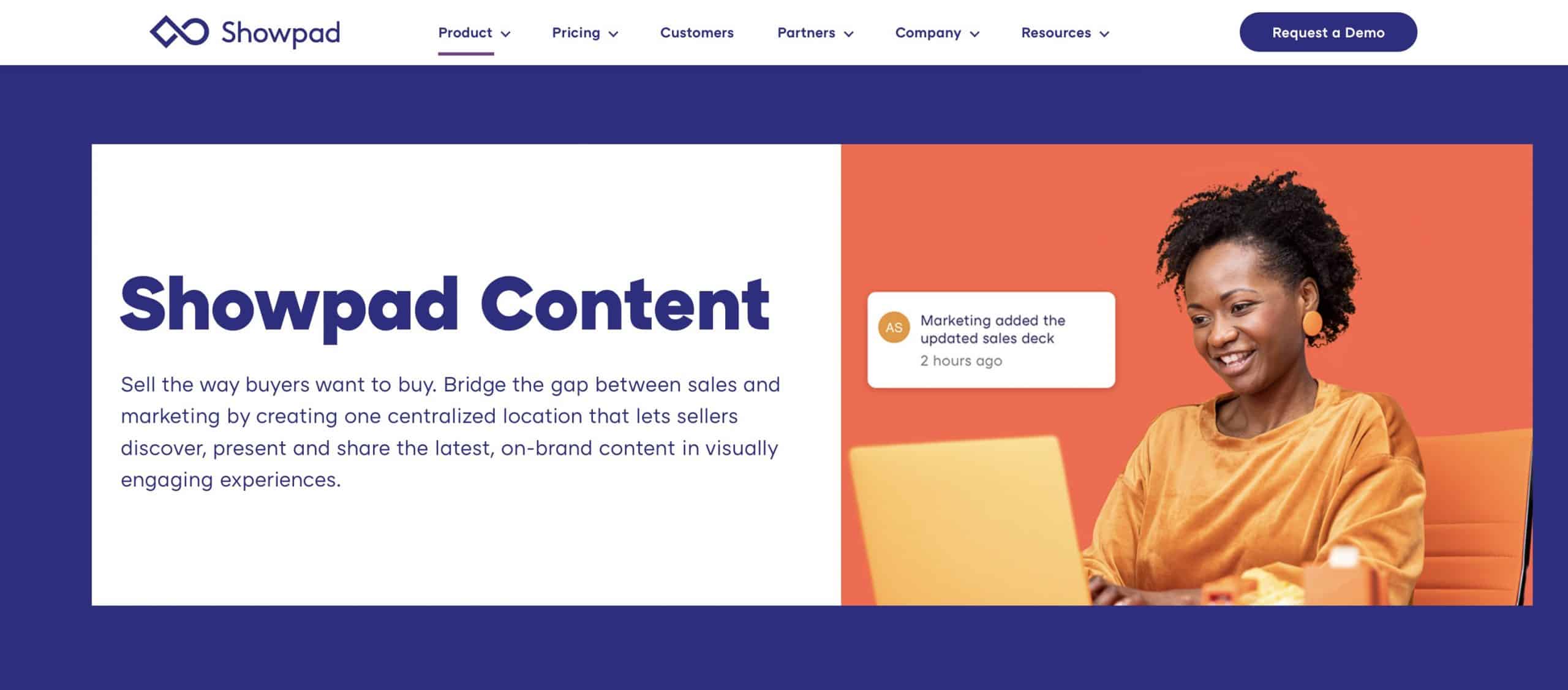
Showpad Content is a platform that helps sales and marketing teams organize and deliver personalized sales materials. It is content-centric, focusing on content organization, guided selling, and analytics-driven creation + distribution of personalized sales assets.
As one of the dedicated sales engagement platforms, the features included are focused on content discovery, AI-driven search, online storage, analytics, asset distribution, and collaboration.
Pros:
- Comprehensive support resources, including device-specific instructions and videos.
- User-friendly software and an excellent support team enable rapid setup.
- Clean interface and user experience, considered the most accessible solution by users.
- Easy to use, with customers/leads appreciating the ability to access resources anytime.
Cons:
- It is not optimized for PCs as well as for iOS systems.
- Setting up channels, tags, and users with a complex admin user flow is tedious.
- Very limited design options; cannot change fonts or customize to brand standards.
- Content uploading can be time-consuming for administrators, though not a deal-breaker.
Plans & Pricing:
- Essential (Contact Sales)
- Plus (Contact Sales)
- Ultimate (Contact Sales)
Customer Ratings:
- G2: 4.6 out of 5 (1,684 reviews)
- Capterra: 4.4 out of 5 (55 reviews)
7. ClearSlide
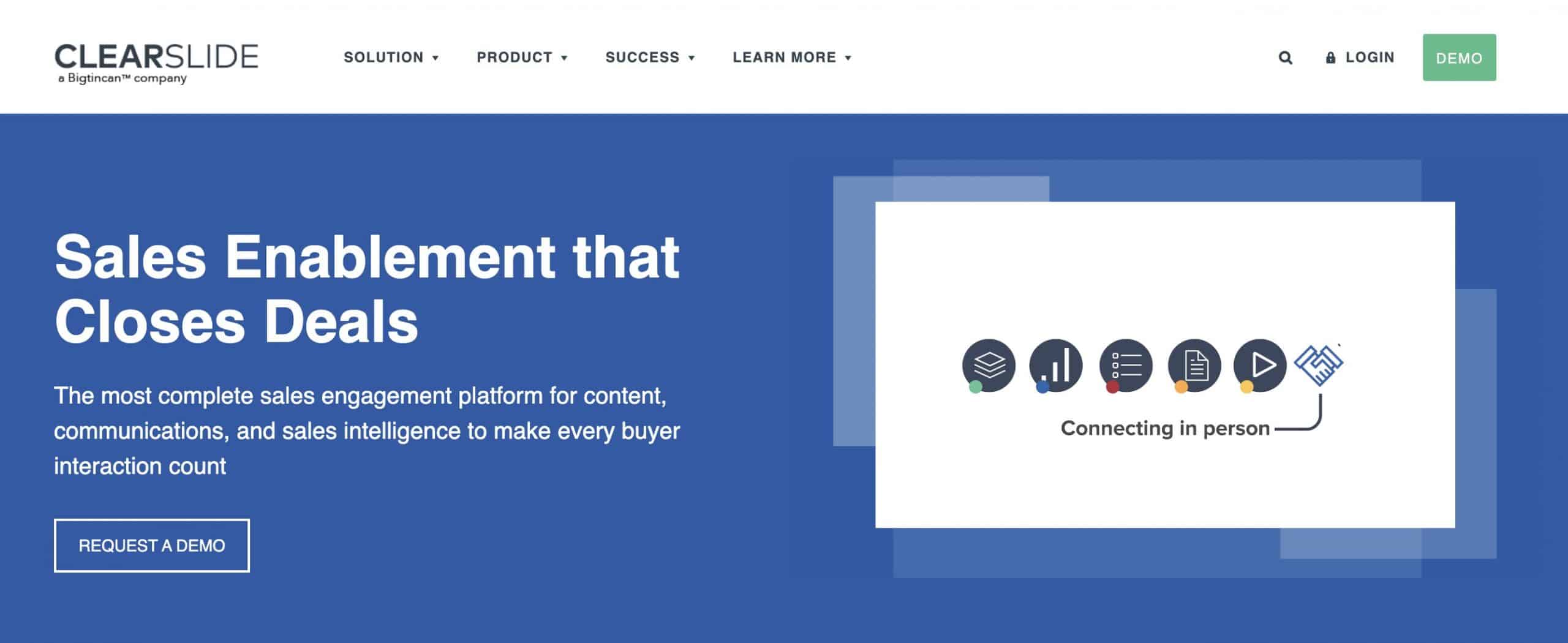
ClearSlide is both a sales enablement and content management software – it tracks how customers interact with company materials like emails and pitch decks. Its features include content management, email/campaign tracking, engagement analytics, and CRM integration.
While it doesn’t have eSignature and in-depth security features like DocuSend, Clearside makes up for it using file accessibility. Buyers, sales reps, and stakeholders can collaborate holistically within a sales-enabling platform to arrive at mutually beneficial outcomes.
Pros:
- Stable, user-friendly software with useful sales tools.
- Organizes and sends mass messages efficiently and effectively.
- Facilitates easy sharing with clients, prospects, and library-wide file updates.
- Enhances presentations and meetings and tracks client engagement effectively.
Cons:
- Remote meeting functionality can be unreliable due to technical issues.
- Billing practices were criticized, with some sales teams finding it unsuitable.
- Viewer details may be misleading when sending materials to multiple recipients.
- Clients sometimes struggle to locate the “Share Screen” button.
Plans & Pricing:
- Pro ($35)
- Group ($65)
- Enterprise ($95)
Customer Ratings:
- G2: 4.1 out of 5 (502 reviews)
- Capterra: 4 out of 5 (55 reviews)
8. Proposify
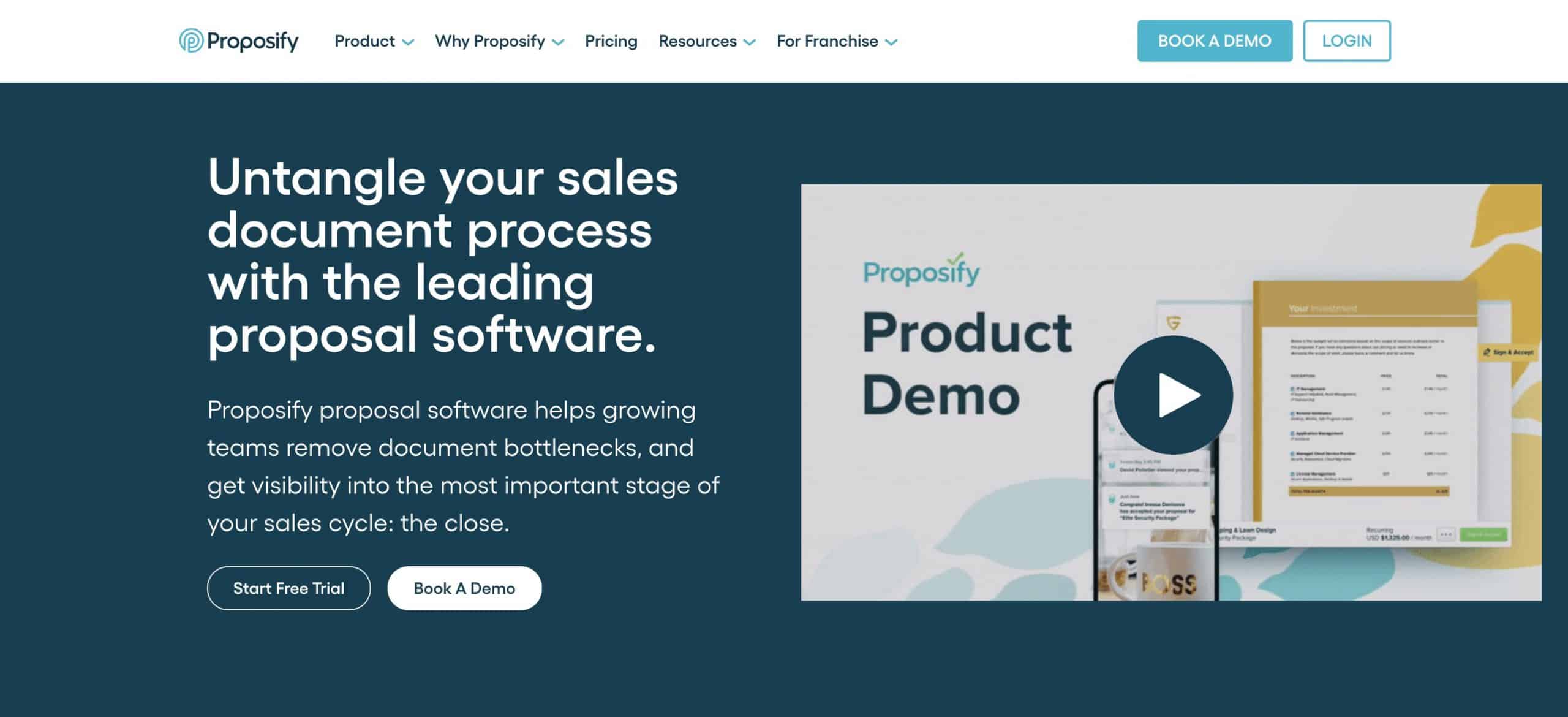
Proposify is a proposal creation and management software that focuses on streamlining proposal workflows for personalized sales content. It helps sales reps manage sales communications, quotes, and proposals in one place while staying consistent with branding.
If your company is focused on personalizing your outreach and sales materials without needing in-depth tracking and signing, Proposify can be a better fit for your company. Unfortunately, they only provide Sales force integration and single sign-on to higher tiers.
Pros:
- Converts reluctant users into enthusiastic adopters eager to explore more.
- Enables quick creation of visually compelling proposals using pre-stored content.
- Offers excellent customer support and digital signature options with robust design choices.
- Clients appreciate the software’s solution to traditional proposal issues.
Cons:
- Contact search is problematic due to software faults.
- Known for frequent crashes and unresolved bugs.
- Some features may respond slowly or be somewhat unstable.
- Lacks a requested subtotal line in pricing tables.
Plans & Pricing:
- Team Plan ($49)
- Business Plan (Contact Sales)
Customer Ratings:
- G2: 4.6 out of 5 (951 reviews)
- Capterra: 4.5 out of 5 (274 reviews)
9. Showell
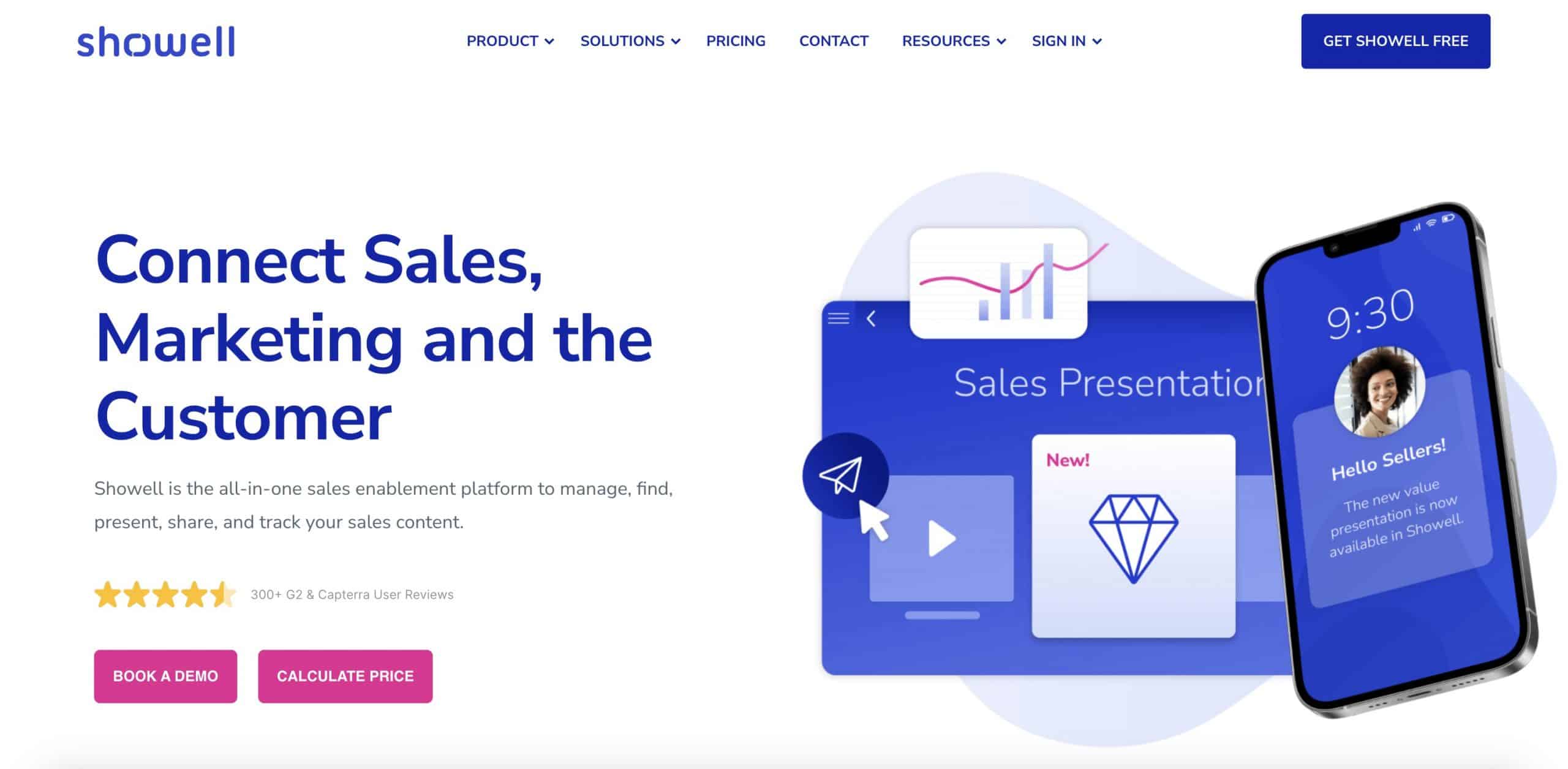
Showell is a sales enablement platform that equips sales teams to provide personalized buyer experiences. This platform can improve sales experience by allowing customer-facing teams to present, share, and track sales content effectively.
It needs more focus on the proposal/sales material creation process. Instead, it facilitates the effective and practical execution of interactive presentations, analytics, and product onboarding. This software is tailored for sales teams that need to facilitate virtual selling experiences.
Pros:
- Intuitive interface and dynamic features simplify presentation creation and sharing.
- The excellent support and account management team is always ready to assist.
- Works well across multiple devices.
- Facilitates easy sharing outside the organization and tracks engagement.
Cons:
- The platform can be clunky and slow at times.
- Analytics and data presentation could be more intuitive and clearer.
- Limited thumbnail icons/images for folders, with no customization option.
- Requires setting each folder as shareable in admin before creating share links.
Plans & Pricing:
- Free
- Essential ($25)
- Professional (Contact Sales)
- Enterprise (Contact Sales)
Customer Ratings:
- G2: 4.5 out of 5 (220 reviews)
- Capterra: 4.6 out of 5 (164 reviews)
10. Highspot
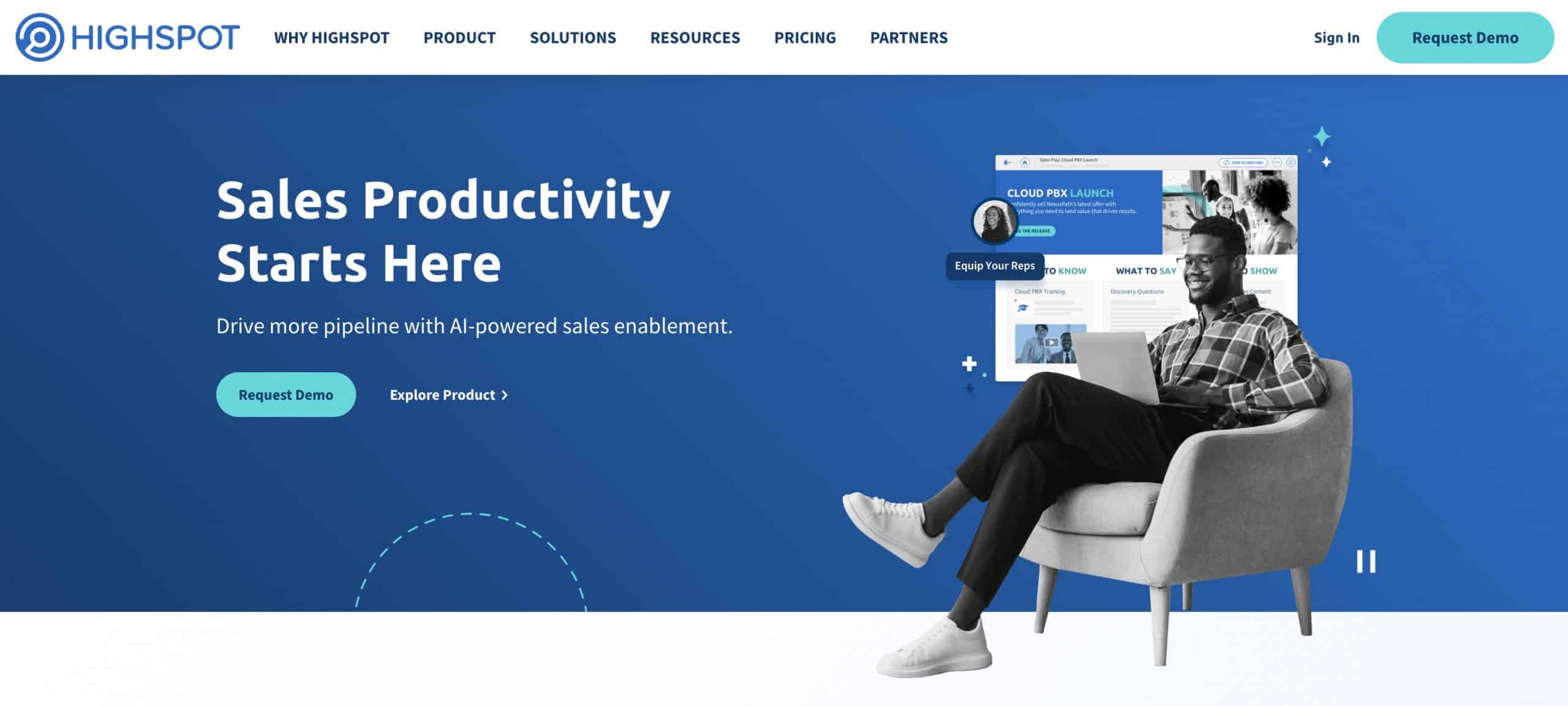
Highspot is a sales enablement software that addresses the gap between strategy and execution of sales models. You can organize content effectively, facilitate guided selling, generate pitches, and gather insights from analytics.
This software suite enables users to create, browse, and deliver branded content / critical information through multiple platforms to ensure that all customers are appropriately engaged. It also focuses on standardizing the branding across these channels to maximize brand visibility.
Pros:
- Organizes resources efficiently, with simple previews before downloading or sharing.
- It centralized materials like PDFs and media, offering intuitive and related search results.
- Allows easy content upload and sharing, with tracking of client engagement.
- Provides content organization, guided selling, and pitch creation in one platform.
Cons:
- Initial use of the interface can be non-intuitive and challenging.
- Some users still need to decide about the software’s ease of use.
- Users reported complexity for its features, in addition to higher pricing.
Plans & Pricing:
- Contact Sales
Customer Ratings:
- G2: 4.7 out of 5 (1,076 reviews)
- Capterra: 4.6 out of 5 (44 reviews)
Summary
While DocSend remains a powerful tool, exploring alternatives can reveal features and pricing structures better suited to your needs. This list offers a starting point – take the time to carefully evaluate each option before making your final decision.
If you want free alternatives to DocSend, with team management features, a generous free trial period, and cost-effective subscription plans, you might want to try Ahsuite.
Ahsuite client portal allows teams and clients to share and review files securely within the browser. Manage your content with its file manager and track ongoing tasks with task management tools.
Easily control who shares and views your content with 1-click permission controls. Join Ahsuite for free (for 10 portals) with the Starter Plan.

